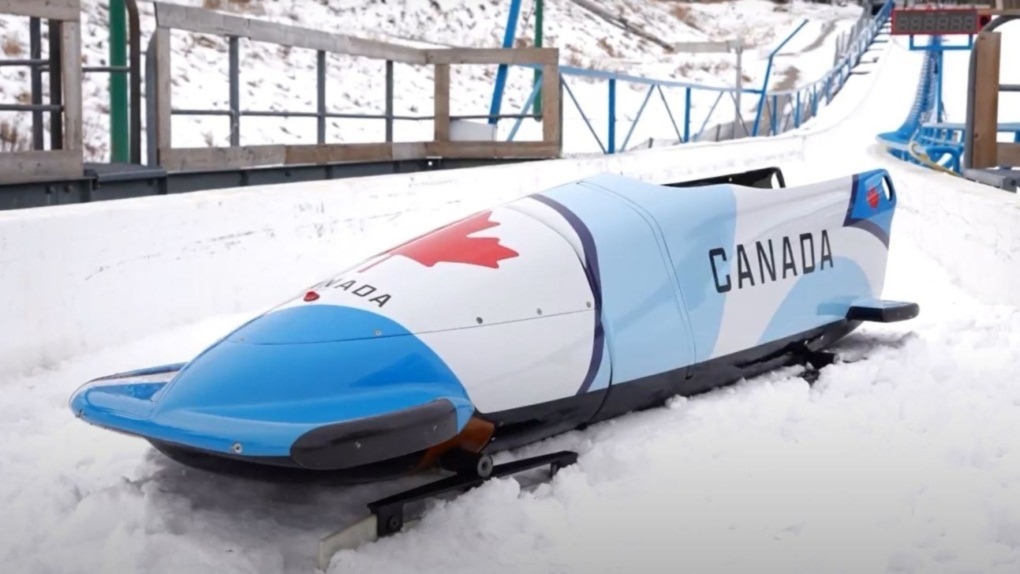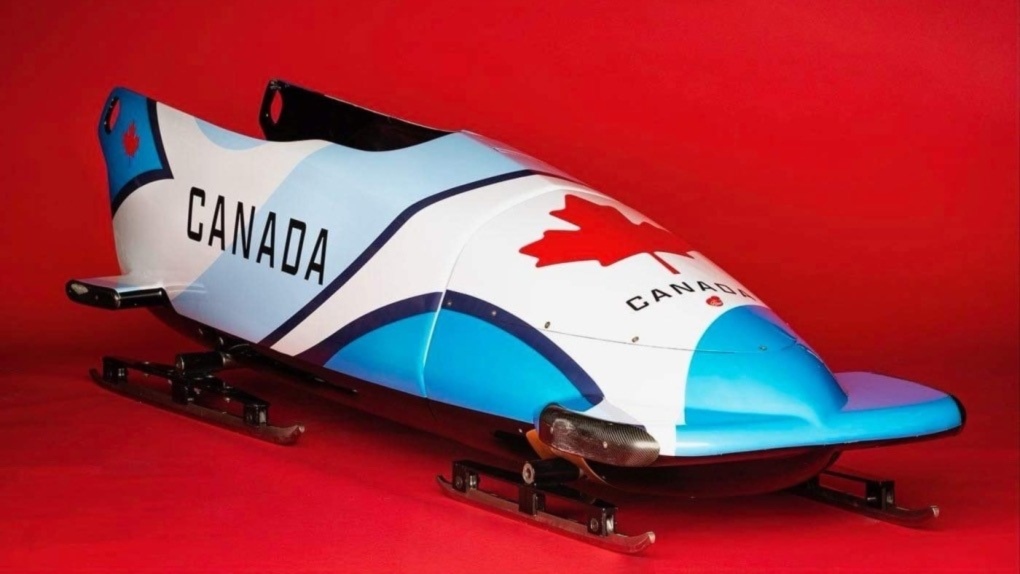Royal Canadian Navy members put skills to the test with bobsleigh, skeleton athletes
 Navy-inspired bobsled design. (Photo courtesy: Bobsleigh Canada Skeleton)
Navy-inspired bobsled design. (Photo courtesy: Bobsleigh Canada Skeleton)
Members of the Royal Canadian Navy put their sliding skills to the test this week in Calgary as part of a partnership with some of the country's top bobsleigh and skeleton athletes.
Over the last three Olympic quadrennials, Bobsleigh Canada Skeleton has found creative ways to connect with the Canadian Armed Forces.
Both land and air members previously had the chance to try out the sport, and this week was time for seven sailors to strap on spiky shoes and helmets for a special sliding session in the Ice House at WinSport.
Command Master Sailor of the Royal Canadian Navy Jeremy Harvey says the aim of learning this particularly unique skill was centred around developing strong team building.
"So when we're a civilian, and then we become a Canadian Armed Forces member, it's not a job anymore, it's a lifestyle. It's the same as somebody that is trying to go for the Olympics, it becomes their life," he said.
"Some of the things we have to do, like them, is learn resiliency, hard work, determination. We have to stay fit for our job and work in very close quarters. It's the same as a bobsled, we're stuck in a ship that we can't get off and we have to work very closely with everybody, and it doesn't matter if we like them or not, we have to be able to work in the best way possible."
Others, like Kelsey Stilwell, a sailor first class with HMCS Tecumseh, admit that bobsledding has absolutely nothing to do physically with her job, but there's plenty of mental notes she took from the session.
"I find in my role as a recruiter, I spend a lot of time talking to people, asking questions and encouraging them to find their path," she said.
"So as far as challenging yourself, it sounds like Olympic bobsledders really have to be fit and in peak condition, working really hard, and that's something we do, we push ourselves to our limits to 110 per cent of what we can do."
Commander of the Royal Canadian, vice-admiral Angus Topshee, was also able to take a moment away from his job to reflect on how these new sliding skills can help him and his crew members adapt to difficult situations.
 Members of the Royal Canadian Navy put their skills to the test in Calgary as part of a partnership with some of the country's top bobsleigh and skeleton athletes."If I've got a radar operator who's on the display and needs to be alert all of that time, it's not just about the physical fitness, it's about their wellness across the whole spectrum, their sleep hygiene. A lot of high performance athletes have learned things there on how to prepare," he said.
Members of the Royal Canadian Navy put their skills to the test in Calgary as part of a partnership with some of the country's top bobsleigh and skeleton athletes."If I've got a radar operator who's on the display and needs to be alert all of that time, it's not just about the physical fitness, it's about their wellness across the whole spectrum, their sleep hygiene. A lot of high performance athletes have learned things there on how to prepare," he said.
"I'm not saying I'm going to turn Canadian Navy sailors into high-performance athletes or push them down a track to the same degree as these guys, but we can learn from how they make sure that they're getting peak performance out of their people. That's what we're looking to take away."
LEARNING FROM THE BEST
Dawn Richardson Wilson, a Canadian bobsleigh athlete from Edmonton, made her international debut in November 2018 on the North American Cup Circuit and stood on her first podium at the end of that month in Lake Placid, N.Y., alongside pilot Kori Hol.
She won her first race in January 2019 and became a full-time World Cup brakewoman before competing in the Beijing 2022 Olympics.
Richardson Wilson says showing members of the Royal Canadian Navy how she trains was a fun learning experience for both sides.
"There's a lot of mental work that goes into this," she said. "We both have to think about time and calculations and the preparations of trusting your team members."
"That's the biggest similarity, is learning how to mentally prepare yourself."
 Members of the Royal Canadian Navy put their skills to the test in Calgary as part of a partnership with some of the country's top bobsleigh and skeleton athletes.Canadian skeleton racer, Barrett Martineau also competed at the 2018 Winter Olympics in PyeongChang, South Korea, and previously won seven America Cups and three Canadian National Titles.
Members of the Royal Canadian Navy put their skills to the test in Calgary as part of a partnership with some of the country's top bobsleigh and skeleton athletes.Canadian skeleton racer, Barrett Martineau also competed at the 2018 Winter Olympics in PyeongChang, South Korea, and previously won seven America Cups and three Canadian National Titles.
He knows what it takes to compete at the highest level and notices the same level of dedication from members of the navy.
"We're all together for the flag here, we're competing for Canada, they're contesting for our country so on that side we're aligned, but we both have to be on our feet, we're hard-core, running at full capacity, we're trying our best and putting our heart and soul into something we love," he said.
CANADIAN BOBSLED DESIGN HONOURS ROYAL CANADIAN NAVY
 Navy-inspired bobsled design. (Photo courtesy: Bobsleigh Canada Skeleton)In 2022, the Canadian navy got a rare shout out at the Beijing Winter Olympics when their sleds were designed with a Second World War-era disruptive paint scheme, also known as dazzle paint.
Navy-inspired bobsled design. (Photo courtesy: Bobsleigh Canada Skeleton)In 2022, the Canadian navy got a rare shout out at the Beijing Winter Olympics when their sleds were designed with a Second World War-era disruptive paint scheme, also known as dazzle paint.
The special blue and white design was meant to honour the sacrifices of Canadian sailors during the Second World War and celebrate those who continue to serve the country at sea.
Canadian frigate HMCS Regina and coastal defence vessel HMCS Moncton donned the commemorative dazzle paint scheme in 2020 to mark the 75thanniversary of the end of the Battle of the Atlantic.
The battle was the longest fight of the Second World War, in which dozens of Canadian ships were sunk by German vessels in the struggle for control over the North Atlantic from 1939 to 1945.
CTVNews.ca Top Stories

Donald Trump says he urged Wayne Gretzky to run for prime minister in Christmas visit
U.S. president-elect Donald Trump says he told Canadian hockey legend Wayne Gretzky he should run for prime minister during a Christmas visit but adds that the athlete declined interest in politics.
Historical mysteries solved by science in 2024
This year, scientists were able to pull back the curtain on mysteries surrounding figures across history, both known and unknown, to reveal more about their unique stories.
King Charles III focuses Christmas message on healthcare workers in year marked by royal illnesses
King Charles III used his annual Christmas message Wednesday to hail the selflessness of those who have cared for him and the Princess of Wales this year, after both were diagnosed with cancer.
Mother-daughter duo pursuing university dreams at the same time
For one University of Windsor student, what is typically a chance to gain independence from her parents has become a chance to spend more time with her biggest cheerleader — her mom.
Thousands without power on Christmas as winds, rain continue in B.C. coastal areas
Thousands of people in British Columbia are without power on Christmas Day as ongoing rainfall and strong winds collapse power lines, disrupt travel and toss around holiday decorations.
Ho! Ho! HOLY that's cold! Montreal boogie boarder in Santa suit hits St. Lawrence waters
Montreal body surfer Carlos Hebert-Plante boogie boards all year round, and donned a Santa Claus suit to hit the water on Christmas Day in -14 degree Celsius weather.
Canadian activist accuses Hong Kong of meddling, but is proud of reward for arrest
A Vancouver-based activist is accusing Hong Kong authorities of meddling in Canada’s internal affairs after police in the Chinese territory issued a warrant for his arrest.
New York taxi driver hits 6 pedestrians, 3 taken to hospital, police say
A taxicab hit six pedestrians in midtown Manhattan on Wednesday, police said, with three people — including a 9-year-old boy — transported to hospitals for their injuries.
Azerbaijani airliner crashes in Kazakhstan, killing 38 with 29 survivors, officials say
An Azerbaijani airliner with 67 people onboard crashed Wednesday near the Kazakhstani city of Aktau, killing 38 people and leaving 29 survivors, a Kazakh official said.






























